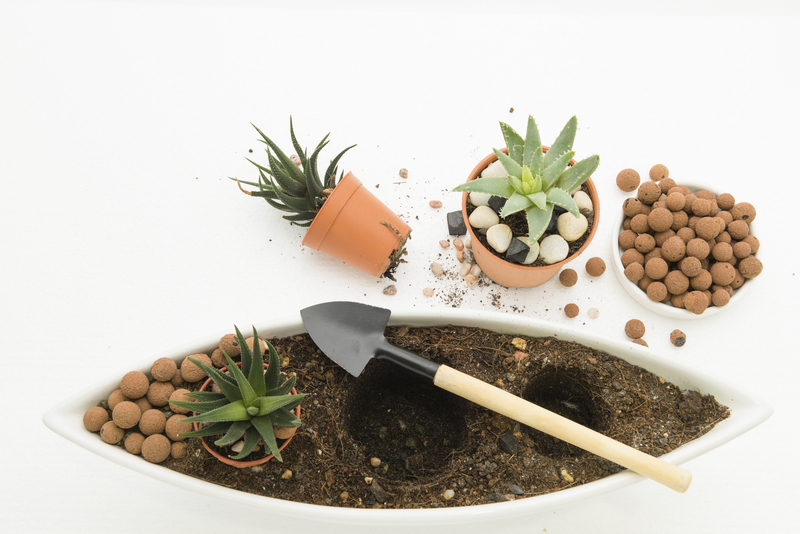Tips to Safeguard Your Garden Against Stormy Weather
Posted on 25/09/2025
Tips to Safeguard Your Garden Against Stormy Weather
Is your garden prepared for stormy weather? As climate patterns shift and extreme weather events become more frequent, it's crucial for every gardener to understand how to protect their outdoor spaces from the threats posed by heavy rains, strong winds, and hail. In this comprehensive guide, you'll discover practical tips and strategies to help safeguard your garden against storm damage, ensuring that your plants and landscape survive even the wildest weather.
Table of Contents
- Why Protect Your Garden from Storms?
- Planning a Storm-Resilient Garden
- Before the Storm: Preparation Steps
- Safety Tips During the Storm
- After the Storm: Recovery and Assessment
- Long-Term Protection Strategies
- Frequently Asked Questions
- Conclusion
Why Protect Your Garden from Storms?
Gardeners invest love, time, and effort into their gardens--beautiful oases that provide food, relaxation, and enjoyment. Unfortunately, severe weather can undo months or even years of hard work in a matter of minutes. Stormy weather brings a range of hazards, including:
- Strong winds that uproot or break plants
- Heavy rainfall leading to flooding or soil erosion
- Hail damage bruising leaves, stems, and fruit
- Lightning strikes that can harm trees and larger plants
- Sudden temperature drops causing plant stress
Not only does this impact the visual appeal of your garden, but it can also halt food production and cause expensive damage. That's why implementing garden storm protection measures is critical. Fortunately, with the right preparation, you can minimize storm damage, preserve your landscape, and encourage faster recovery.
Planning a Storm-Resilient Garden
Choose Storm-Resistant Plants
Certain plants naturally withstand intense weather better than others. When planning or updating your garden, consider:
- Deep-rooted trees and shrubs, which are less prone to being uprooted
- Flexible stems that bend in the wind rather than snap
- Native plants that adapt well to local weather extremes
Strategic Garden Layout
Landscape design plays a crucial role in storm protection for gardens. For a more resilient garden:
- Group plants in clusters to buffer each other from wind
- Plant windbreaks such as hedges, fences, or trellises on the sides facing prevailing winds
- Raise beds to improve drainage and prevent root rot from heavy rain
- Mulch flowerbeds to reduce soil erosion
Install Effective Drainage Systems
Poor drainage is a major cause of garden storm damage. To keep water from pooling, especially during torrential rain:
- Install French drains or gravel trenches along critical paths
- Add organic matter to clay soils for improved permeability
- Direct downspouts away from vulnerable garden areas
Before the Storm: Preparation Steps
Stay Informed and Monitor Weather
The first step in protecting your garden from severe storms is knowing when one is brewing. Use smartphone weather alerts or gardening apps to receive real-time updates. This allows you to act quickly before a storm hits.
Secure Loose Garden Structures
Garden furniture, trellises, and ornaments can become hazardous in high winds. Take these steps:
- Store movable items indoors or in a shed
- Anchor raised beds or cold frames securely to the ground
- Bind together stake-supported plants with garden twine
Protect Vulnerable Plants
Some plants are more susceptible to storm damage than others. To prevent breakage:
- Stake young trees, tall flowers, and vegetables so they remain upright during gales
- Cover delicate crops with netting, cloches, or even upturned pots (for small plants)
- Prune dead or excess branches from trees and shrubs to reduce wind resistance
Prepare Soil and Beds
Soil that's already waterlogged or compacted is more prone to erosion. Prepare by:
- Aerating soil ahead of big rain to absorb more water
- Adding organic mulch to lock in nutrients and reduce runoff
Safety Tips During the Storm
Once the weather hits, your focus should shift to personal safety. Never put yourself at risk to secure garden items during a storm.
- Stay indoors and away from trees, greenhouses, or sheds during high winds or lightning
- Turn off irrigation systems to avoid over-saturating the ground during heavy rain
- Monitor local advisories for flood or storm updates
Remember: property can be replaced--your wellbeing is irreplaceable.
After the Storm: Recovery and Assessment
Inspect Your Garden Carefully
Once it's safe, inspect your garden for damage. Focus on:
- Flooded areas or standing water
- Broken branches, stems, or uprooted plants
- Toppled furniture or dislodged structures
Support and Salvage Storm-Affected Plants
Not all storm-damaged plants are lost. With prompt care, many recover:
- Prune damaged stems and leaves with clean tools to prevent rot and disease
- Re-stake and firm up plants that have shifted or toppled
- Remove debris from beds to discourage pests
- Apply a mild fertilizer to boost plant immunity and regrowth
Address Soil and Water Issues
Heavy rain can strip soil nutrients and compact the earth:
- Loosen compacted soil with a fork, add compost or mulch
- Check for signs of root rot in waterlogged areas
- Flush salt or chemical buildup (if flooding occurred) by running clean water through the soil once stormwater has receded
Monitor for Pests and Disease
Storm aftermath often leads to increased pests and fungal infections:
- Remove decaying leaves and keep beds clean to reduce disease risk
- Apply organic fungicides if necessary
- Attract beneficial insects to help control pests naturally
Long-Term Protection Strategies
Invest in Stronger Garden Infrastructure
Over time, upgrade your garden's structural defenses:
- Install durable fences and privacy screens as windbreaks
- Choose sturdy greenhouses and sheds designed for high winds
- Maintain regular inspections to catch and repair weaknesses before the next storm
Improve Drainage Continuously
Constantly assess if your garden's drainage meets its needs, especially as planting layouts change:
- Use raised beds for vegetables in areas with heavy rainfall
- Create rain gardens with water-loving plants to absorb excess moisture
- Install permeable paving for paths and patios to reduce runoff
Adopt Sustainable Garden Practices
Sustainable landscaping can make your garden more resilient to stormy weather:
- Plant dense groundcovers to hold soil against erosion
- Mulch regularly with organic materials to preserve soil health
- Encourage biodiversity for a healthier, more robust garden ecosystem
Frequently Asked Questions about Garden Storm Protection
Can I prevent all storm damage to my garden?
No garden is completely stormproof, but implementing the strategies above can significantly reduce risks and help your garden recover more quickly after extreme weather.
How can I protect my vegetable garden from floods?
Raised beds with proper drainage are the most effective way to protect vegetable gardens from flooding. Mulch heavily and use soil amendments to improve water absorption. After flooding, inspect root systems for rot and wait until the soil dries before replanting.
What's the best windbreak for gardens?
Living windbreaks such as dense hedges (like laurel, privet, or bamboo) are ideal. Alternatively, sturdy wooden fences or lattice panels can be effective. Ensure your windbreak is set at the correct height and location to shield vulnerable areas.
How often should I review my garden's storm resilience?
At least once a season, walk through your garden to check for potential storm hazards, such as overgrown trees, loose structures, or poor drainage. Regular reviews help you address issues before a storm arrives.
Are there tech solutions for monitoring garden weather conditions?
Yes. Weather monitoring stations, smart irrigation systems, and gardening apps can help you track rainfall, humidity, and wind speed, giving you early warnings to take action.
Conclusion
Protecting your garden from stormy weather requires a blend of careful planning, practical actions, and ongoing vigilance. By following the garden storm protection tips outlined above, you'll not only save yourself time and heartache after severe weather, but you'll also create a more resilient and beautiful landscape for all seasons.
- Plan ahead with smart plant choices and garden layout
- Act quickly to secure and protect vulnerable plants and structures before storms
- Respond effectively after severe weather to aid recovery and minimize losses
Your garden is an investment in beauty, nutrition, and wellbeing--don't let stormy weather take that away. Integrate these strategies into your routine today and reap the benefits all year round!
Looking for more gardening advice? Explore our blog for further tips on plant care, landscaping, and sustainable gardening solutions.



